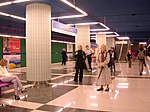Świętokrzyska Street, Warsaw
Odonyms referring to religionPoland road stubsStreets in WarsawWarsaw geography stubs

Ulica Świętokrzyska (Holy Cross Street) in Warsaw's city centre is one of the Polish city's principal thoroughfares. It links the city's centre with Wola borough. The street is named for Holy Cross Church, which stands on Krakowskie Przedmieście. Named after the street are a Warsaw Metro station and the Świętokrzyski Bridge. The street was closed to traffic and trams from 2011 to March 2015 due to the construction of Warsaw's second Metro line (which runs underneath the length of the street).
Excerpt from the Wikipedia article Świętokrzyska Street, Warsaw (License: CC BY-SA 3.0, Authors, Images).Świętokrzyska Street, Warsaw
Świętokrzyska, Warsaw Śródmieście (Warsaw)
Geographical coordinates (GPS) Address Nearby Places Show on map
Geographical coordinates (GPS)
| Latitude | Longitude |
|---|---|
| N 52.235277777778 ° | E 21.009444444444 ° |
Address
Świętokrzyska 35
00-049 Warsaw, Śródmieście (Warsaw)
Masovian Voivodeship, Poland
Open on Google Maps










